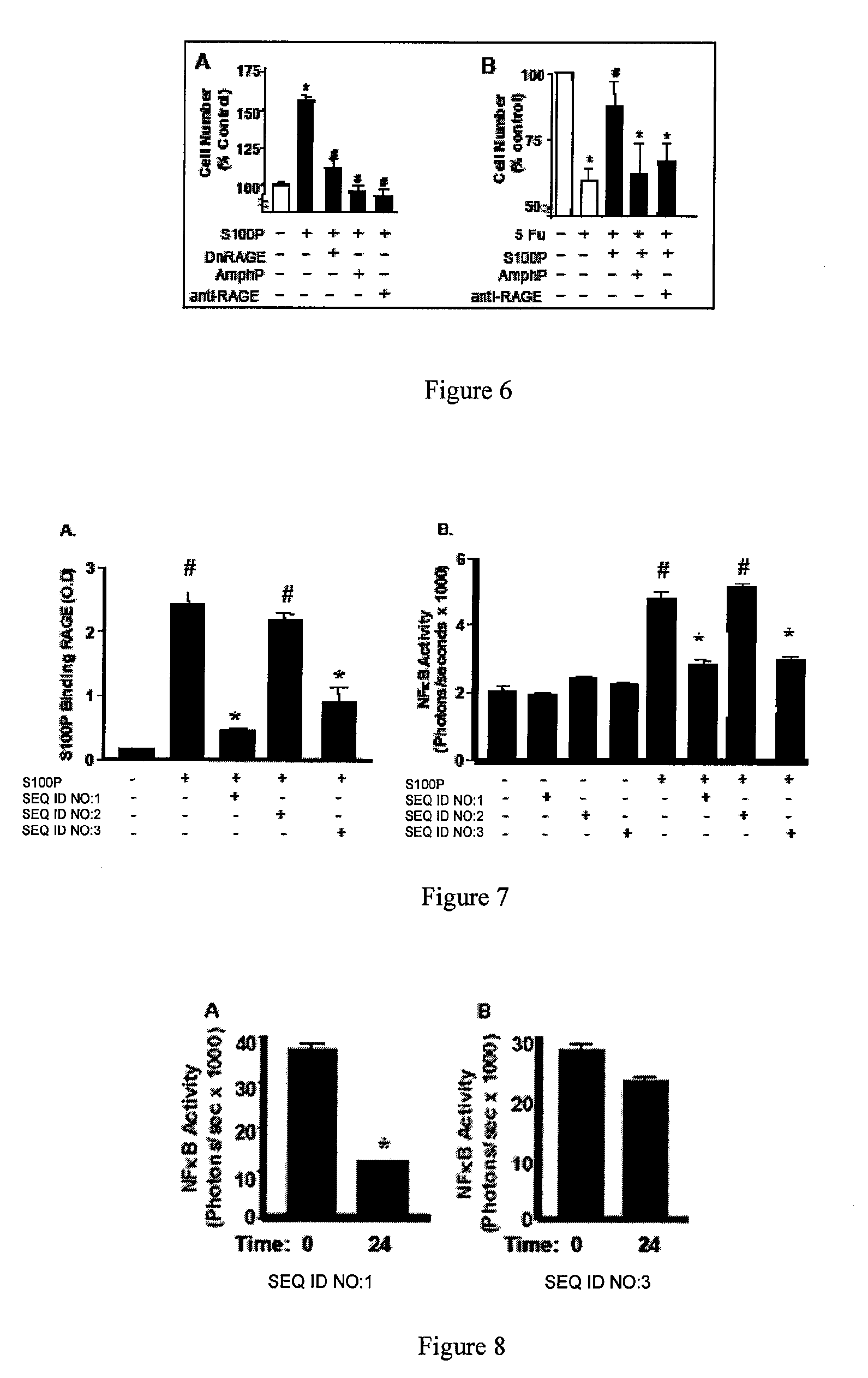Antagonists of the receptor for advanced glycation end-products (RAGE)
a technology of rage and end-products, which is applied in the direction of drug compositions, peptide sources, peptide/protein ingredients, etc., can solve the problems of over-expression of rage ligands in many types of cancer
- Summary
- Abstract
- Description
- Claims
- Application Information
AI Technical Summary
Benefits of technology
Problems solved by technology
Method used
Image
Examples
example i
S100P Stimulates Pancreatic Tumor Growth In Vivo
[0117]To directly determine the importance of S100P on pancreatic cancer, we examined the tumors formed from pancreatic cancer cell models over- and under-expressing S100P. We observed that WT Panc-1 cells, which do not express S100P, formed tumors, indicating that S100P is not required for tumor growth. However, expression of S100P in Panc-1 cells greatly increased the size of tumors as shown in FIG. 3A. Likewise, silencing of S100P by stable expression of a shRNA against S100P in BxPC3 cells reduced the size of tumors as shown in FIG. 3B. Similarly, we have observed that silencing S100P in Mpanc96 and MiaPaca2 cells also inhibits tumor growth in vivo (data not shown). Thus, while not necessary for tumor development, S100P stimulates the growth and the aggressiveness of pancreatic cancer. In FIG. 3A, athymic mice were inoculated subcutaneously with 1×106 of either vector transfected or S100P expressing Panc-1 cells. Tumor volume was c...
example ii
S100P Stimulates Endothelial Cell Proliferation and Migration In Vitro
[0118]S100P is secreted by pancreatic cancer cells and acts in an autocrine manner to stimulate their growth, survival, and invasiveness. Thus, S100P could also interact with receptors on cells within the microenvironment. The effects of S100P on human umbilical vein endothelial cells (HUVECs) in vitro were examined. As shown in FIG. 4A, S100P treatment for 48 hrs caused a significant increase in HUVEC cell numbers. HUVEC cells were cultured in the presence of either S100P or uninduced bacterial protein for 48 hours and the number of cells was estimated using MTS. FIG. 4B shows CD31 staining of tumors formed from pancreatic cancer cells orthotopically implanted in nude mice. Tumors formed with BxPC3 cells were harvested and frozen sections were stained for CD31 staining with the help of the Cancer Biology Histology core. Microvessels bearing CD31 are stained brown. In a different assay, shown in FIG. 4C, Applicant...
example iii
S100P and RAGE
[0119]Whether S100P could interact with RAGE was investigated and found that it could in both pancreatic cancer and NIH 3T3 cells. As a direct indication of this interaction, lysates from Panel, and MiaPaca2 cells were incubated with S100P and S100P was then immunoprecipitated. The resulting product was washed, run on an SDS PAGE gel, and blotted with an antibody specific for RAGE as shown in FIG. 5. RAGE was not present in the samples run without addition of S100P or S100P antibody (lanes A-C), but RAGE was present when both these reagents were included (lanes D-F). These data indicate that S100P is able to interact directly with RAGE. In these experiments MiaPaca2 (A-D) and BxPC3-1 (E) cell lysates were incubated in the presence of S100P (100 ng) for 16 hours at 4° C. before immunoprecipitation with anti-S100P monoclonal antibodies (IP-S100P) (+) or control IgG (−) and RAGE was identified in the immunoprecipitates by western blotting with an anti-RAGE antibody (IB-RA...
PUM
| Property | Measurement | Unit |
|---|---|---|
| Fraction | aaaaa | aaaaa |
| Therapeutic | aaaaa | aaaaa |
Abstract
Description
Claims
Application Information
 Login to View More
Login to View More - R&D
- Intellectual Property
- Life Sciences
- Materials
- Tech Scout
- Unparalleled Data Quality
- Higher Quality Content
- 60% Fewer Hallucinations
Browse by: Latest US Patents, China's latest patents, Technical Efficacy Thesaurus, Application Domain, Technology Topic, Popular Technical Reports.
© 2025 PatSnap. All rights reserved.Legal|Privacy policy|Modern Slavery Act Transparency Statement|Sitemap|About US| Contact US: help@patsnap.com



